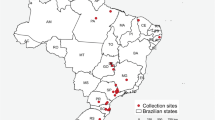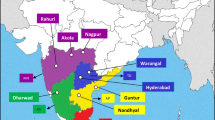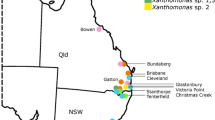Abstract
During 1997 and 1998, serious outbreaks of bacterial leaf spot disease were observed on zinnia plants grown in home and commercial gardens in Ohio, USA. Twenty-two strains of Xanthomonas campestris pv. zinniae, isolated from diseased zinnia plants and contaminated seeds, were identified based on morphological, physiological and biochemical tests, fatty acid methyl ester analyses and pathogenicity tests on zinnia cv. Scarlet. Host range studies indicated that all of the X. campestris pv. zinniae strains were pathogenic on zinnia and tomato, but not on cabbage, lettuce, pepper and radish. The phenotypic and genotypic relationships among the strains determined based on serological reaction pattern, fatty acid profiles, repetitive extragenic palindromic-polymerase chain reaction (rep-PCR) fingerprints and sequence analysis of the 16S–23S rDNA spacer region suggested that X. campestris pv. zinniae strains were closely related to each other, but clearly distinct from other Xanthomonas species including X. campestris pv. campestris, X. axonopodis pv. vesicatoria, X. vesicatoria and X. hortorum pv. vitians tested in this study. The results also demonstrated that rep-PCR fingerprinting is rapid, reliable and the most practical method for routine detection and identification of X. campestris pv. zinniae strains.
Similar content being viewed by others
References
Altschul SF, Madden TL, Schaffer AA, Zhang JH, Zhang Z, Miller W and Lipman DJ (1997) Gapped BLAST and PSI-BLAST: A new generation of protein database search program. Nucleic Acids Research 25: 3389-3402
Alvarez AM, Benedict AA, Mizumoto CY, Hunter JE and Gabriel DW (1994) Serological, pathological and genetic diversity among strains of Xanthomonas campestris infecting crucifers. Phytopathology 84: 1449-1457
Bertus AL and Hayward AC (1971) A bacterial leaf spot of zinnia in New South Wales. Proceedings of the Linnean Society of New South Wales 96: 81-84
Bouzar H, Jones JB, Stall RE, Hodge NC, Minsavage GV, Benedict AA and Alvarez AM (1994) Physiological, chemical, serological, and pathogenic analyses of worldwide collection of Xanthomonas campestris pv. vesicatoria. Phytopathology 84: 663-671
Brosius J, Dull TJ and Noller HF (1980) Complete nucleotide sequence of a 23S ribosomal RNA gene from Escherichia coli. Proceedings of the National Academy of Sciences of the United States of America 77: 201-204
Deighton FC (1957) Plant pathology section. Review of Applied Mycology 36: 381
Gabriel DW, Kingsley MT, Hunter JE and Gottwald TR (1989) Reinstatement of Xanthomonas citri (ex Hasse) and X. phaseoli (ex Smith) and reclassification of all X. campestris pv. citri strains. International Journal of Systematic Bacteriology 39: 14-22
Gurtler V and Stanisich VA (1996) New approaches to typing and identification of bacteria using the 16S-23S rDNA spacer region. Microbiology 142: 3-16
Jones JB, Bouzar H, Stall RE, Almira EC, Robert PD, Bowen BW, Sudberry J, Strickler PM and Chun J (2000) Systematic analysis of xanthomonads (Xanthomonas spp.) associated with pepper and tomato lesions. International Journal of Systematic and Evolutionary Microbiology 50: 1211-1219
Jones JJ and Strider DL (1979) Susceptibility of zinnia cultivars to bacterial leaf spot caused by Xanthomonas nigromaculans f. sp. zinniae. Plant Disease Reporter 63: 449-453
Laguerre G, Allard M, Revoy F and Amarger N (1994) Rapid identification of Rhizobia by restriction fragment length polymorphism analysis of PCR-amplified 16S rRNA genes. Applied and Environmental Microbiology 60: 56-63
Lelliot RA and Stead DE (1987) Methods for the Diagnosis of Bacterial Diseases of Plants. Blackwell Scientific Publication, Oxford
Louws FJ, Fulbright DW, Stephens CT and de Bruijn FJ (1994) Specific genomic fingerprints of phytopathogenic Xanthomonas and Pseudomonas pathovars and strains generated with repetitive sequences and PCR. Applied and Environmental Microbiology 60: 2286-2295
Louws FJ, Fulbright DW, Stephens CT and de Bruijn FJ (1995) Determination of genomic structure by rep-PCR fingerprinting to rapidly classify Xanthomonas campestris pv. vesicatoria. Phytopathology 85: 528-536
Nannizzi A (1929) Una bacteriosi della 'Zinnia elegans' Jacq. (Nota preliminare). Atti Report Accademia Fisiocritici Siena, Ser. X, 416-417
Opgenorth DC, Smart CD, Louws FJ, de Bruijn FJ and Kirkpatrick BC (1996) Identification of Xanthomonas fragariae field isolates by rep-PCR genomic fingerprinting. Plant Disease 80: 868-873
Peregrine WT and Siddiqi MA (1972) A Revised and Annotated List of Plant Diseases in Malawi. Phytopathology Paper 16. Commonwealth Mycology Institute, Kew, Surrey
Rangaswami G and Gowda SS (1963) On some bacterial diseases of ornamentals and vegetables in Madras State. Indian Phytopathology 16: 74-85
Robbs CF (1954) Bacterias fitopatogenicas do Brasil. Agronomia, Rio de Journal 13: 265-282
Sahin F (1997) Detection, identification and characterization of strains of Xanthomonas campestris pv. vesicatoria by traditional and molecular methods, and resistance in Capsicum species to Xanthomonas campestris pv. vesicatoria pepper race 6. PhD thesis, The Ohio State University, Columbus, OH, USA
Sahin F and Miller SA (1997) Identification of the bacterial leaf spot pathogen of lettuce, Xanthomonas campestris pv. vitians in Ohio, and assessment of cultivar resistance and seed treatment. Plant Disease 81: 1443-1446
Sahin F and Miller SA (1998) Two new hosts of Xanthomonas campestris pv. vitians. Plant Disease 82: 262
Sahin F, Abbasi PA, Lewis Ivey ML, Zhang J and Miller SA (2002) Diversity among strains of Xanthomonas campestris pv. vitians, from lettuce. Phytopathology 92: Accepted
Sasser M (1990) Identification of bacteria through fatty acid analysis. In: Klement Z, Rudolph K, Sands D (eds) Methods in Phytobacteriology (pp 199-204) Akademiai Kiado, Budapest
Schaad NW and Stall RE (1988) Xanthomonas. In: Laboratory Guide for Identification of Plant Pathogenic Bacteria, 2nd edn (pp 81-94) American Phytopathological Society, St. Paul, MN
Schaad NW, Vidaver AK, Lacy GH, Rudolph K and Jones JB (2000) Evaluation of proposed amended names of several pseudomonads and xanthomonads and recommendations. Phytopathology 90: 208-213
Sijam K, Chang CJ and Gitaitis RD (1992) Amedium for differentiating tomato and pepper strains of Xanthomonas campestris pv. vesicatoria. Canadian Journal of Plant Pathology 14: 182-184
Sleesman J, White DG and Ellett CW (1973) Bacterial leaf spot of zinnia:Anewdisease in North America. Plant Disease Reporter 57: 555-557
Stall RE, Beaulieu C, Egel D, Hodge NC, Leite RP, Minsavage GV, Bouzar H, Jones JB, Alvarez AM and Benedict AA (1994) Two genetically diverse groups of strains are included in a pathovar of Xanthomonas campestris pv. vesicatoria. International Journal of Systematic Bacteriology 44: 47-53
Steel FJ (1961) The oxidase reaction as a taxonomic tool. Journal of General Microbiology 25: 297-301
Strider DL (1973) Bacterial leaf and flower spot of zinnia in North Carolina. Plant Disease Reporter 57: 1020
Strider DL (1979a) Detection of Xanthomonas nigromaculans f. sp. zinniae in zinnia seed. Plant Disease Reporter 63: 869-873
Strider DL (1979b) Eradication of Xanthomonas nigromaculans f. sp. zinniae in zinnia seed with sodium hypochlorite. Plant Disease Reporter 63: 873-876
Strider DL (1980) Control of bacterial leaf spot of zinnia with captan. Plant Disease 64: 920-922
Suslow IV, Schroth MN and Isaka M (1982) Application of a rapid method for Gram differentiation of plant pathogenic and saprophytic bacteria without staining. Phytopathology 72: 917-918
Swings JG and Civerolo EL (1993) Xanthomonas. 1st edn, Chapman and Hall, London
Van der Mooter M and Swings J (1990) Numerical analysis of 295 phenotypic features of 266 Xanthomonas strains and an improved taxonomy of the genus. International Journal of Systematic Bacteriology 40: 348-369
Van Zyl E and Steyn PL (1990) Differentiation of phytopathogenic Pseudomonas and Xanthomonas species and pathovars by numerical taxonomy and protein gel electrophoregrams. Systematic and Applied Microbiology 13: 60-71
Vauterin L, Rademarker J and Swings J (2000) Synopsis on the taxonomy of the genus Xanthomonas. Phytopathology 90: 677-682
Vauterin L, Swings J and Kersters K (1991) Grouping of Xanthomonas campestris pathovars by SDS-PAGE of proteins. Journal of General Microbiology 137: 1677-1687
Vauterin L, Yang P and Swings J (1996) Utilization of fatty acid methyl esters for the differentiation of new Xanthomonas species. International Journal of Systematic Bacteriology 46: 298-304
Vauterin L, Hoste B, Kersters K and Swings J (1995) Reclassification of Xanthomonas. International Journal of Systematic Bacteriology 45: 472-489
Verdier V, Boher B, Maraite H and Geiger JP (1994) Pathological and molecular characterization of Xanthomonas campestris strains causing disease of cassava (Manihot esculenta). Applied and Environmental Microbiology 60: 4478-4486
Yang P, Vauterin L, Van Canneyt M, Swings J and Kersters K (1993) Application of fatty acid methyl esters for the taxonomic analysis of the genus Xanthomonas. Systematic and Applied Microbiology 16: 47-71
Author information
Authors and Affiliations
Corresponding author
Rights and permissions
About this article
Cite this article
Sahin, F., Kotan, R., Abbasi, P. et al. Phenotypic and Genotypic Characterization of Xanthomonas campestris pv. zinniae Strains. European Journal of Plant Pathology 109, 165–172 (2003). https://doi.org/10.1023/A:1022506621904
Issue Date:
DOI: https://doi.org/10.1023/A:1022506621904




